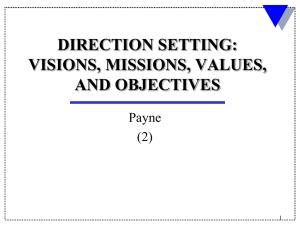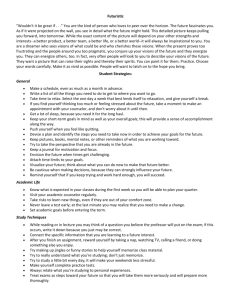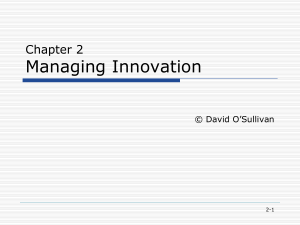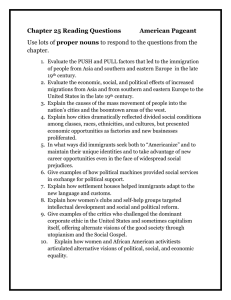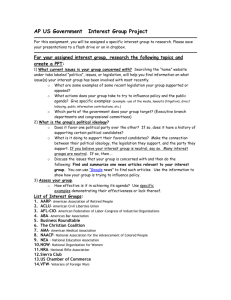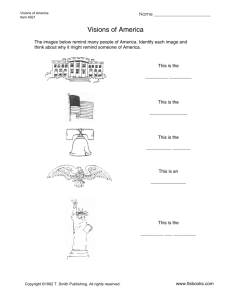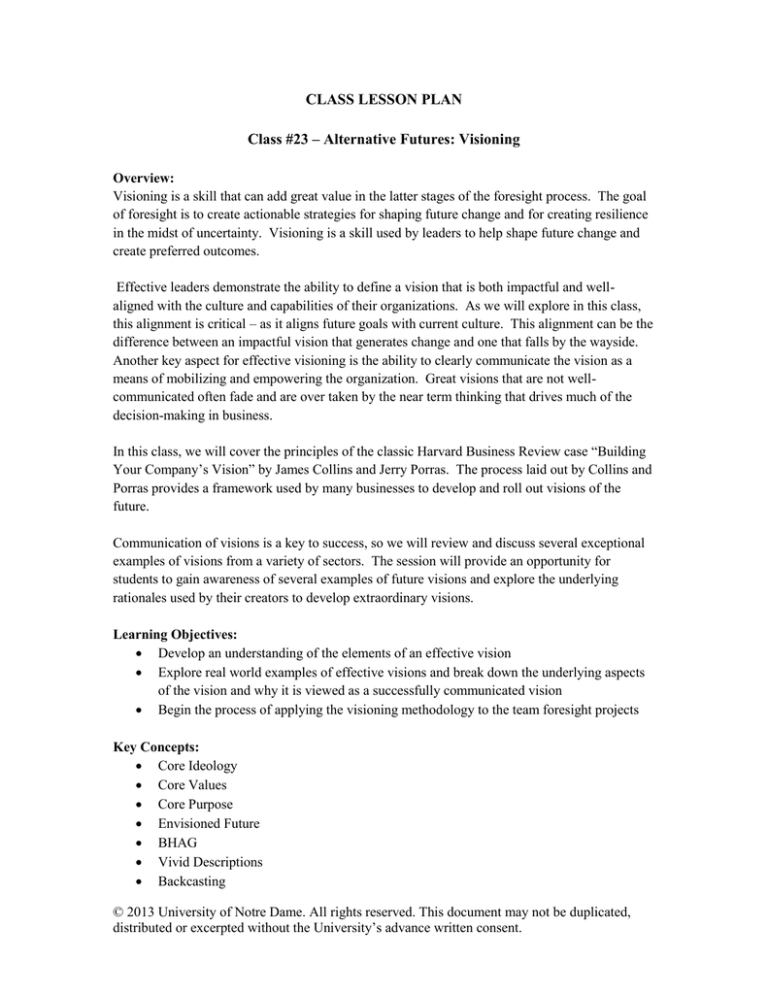
CLASS LESSON PLAN
Class #23 – Alternative Futures: Visioning
Overview:
Visioning is a skill that can add great value in the latter stages of the foresight process. The goal
of foresight is to create actionable strategies for shaping future change and for creating resilience
in the midst of uncertainty. Visioning is a skill used by leaders to help shape future change and
create preferred outcomes.
Effective leaders demonstrate the ability to define a vision that is both impactful and wellaligned with the culture and capabilities of their organizations. As we will explore in this class,
this alignment is critical – as it aligns future goals with current culture. This alignment can be the
difference between an impactful vision that generates change and one that falls by the wayside.
Another key aspect for effective visioning is the ability to clearly communicate the vision as a
means of mobilizing and empowering the organization. Great visions that are not wellcommunicated often fade and are over taken by the near term thinking that drives much of the
decision-making in business.
In this class, we will cover the principles of the classic Harvard Business Review case “Building
Your Company’s Vision” by James Collins and Jerry Porras. The process laid out by Collins and
Porras provides a framework used by many businesses to develop and roll out visions of the
future.
Communication of visions is a key to success, so we will review and discuss several exceptional
examples of visions from a variety of sectors. The session will provide an opportunity for
students to gain awareness of several examples of future visions and explore the underlying
rationales used by their creators to develop extraordinary visions.
Learning Objectives:
Develop an understanding of the elements of an effective vision
Explore real world examples of effective visions and break down the underlying aspects
of the vision and why it is viewed as a successfully communicated vision
Begin the process of applying the visioning methodology to the team foresight projects
Key Concepts:
Core Ideology
Core Values
Core Purpose
Envisioned Future
BHAG
Vivid Descriptions
Backcasting
© 2013 University of Notre Dame. All rights reserved. This document may not be duplicated,
distributed or excerpted without the University’s advance written consent.
Class Preparation:
Readings:
Collins, J. & Porras, J. (1996). Building Your Company's Vision. Harvard Business
Review
Discussion Questions:
1. How does an organization understand what constitutes their core ideology?
2. How does a core ideology shape vision development?
3. Jim Collins indicates that visions need to be big and audacious. What are the benefits
and risks associated with developing visions in this manner?
4. What are some examples of visions you have encountered that connected with you?
What was it about those visions that created that connection?
Assignment Due:
First drafts of Foresight Reports due in class today.
© 2013 University of Notre Dame. All rights reserved. This document may not be duplicated,
distributed or excerpted without the University’s advance written consent.
INSTRUCTOR GUIDELINES
Discussion Launchers:
Bob Dylan’s lyrics from “The Times They Are A Changin” to illustrate the perspective of another
20 year old regarding change. Show the scratchy video of Dylan first performing the song in
1965. Draw attention to a few particular lyrics:
…the slow one now will later be fast
And the present now will later be past, the order is rapidly fadin
And the first one now will later be last
For the times they are a-changin.
Reflect back on the example of Hewlett Packard or Kodak from class 1 – companies that were
first and found themselves left behind because the world had changed and they had not
anticipated or prepared well-enough for it.
Emphasize the perspective of Bob Dylan as a 20 year old – the same age as many of the students
and how he was able to visualize and lead change in the music industry and in society. Suggest
that the students have more capacity to affect change even at a young age than they may realize.
Discussion Questions with Answers
1. How does an organization understand what constitutes their core ideology?
A: Jim Collins, using HP, Sony, Merck, and 3M as examples, says that “it is more important
that you know who you are than where you are going, for where you are going will change as
the world around you changes.” So business needs to reflect on those attributes of the
company and its culture that are enduring and non-negotiable. Collins suggests that you do
not set or create a core ideology, you discover it. It is not decided by looking at the external
environment, but rather by looking inside.
Core ideology has two components:
Core Values- a company’s essential tenets
Core Purpose – a company’s reason for being
In the words of Ralph Larson, CEO of Johnson & Johnson, “The core values embodied in
our credo might be a competitive advantage, but that is not why we have them. We have them
because they define for us what we stand for, and we would hold them even if they became a
competitive disadvantage in certain situations.” Companies need to decide on what values
are core, independent of the current environment – and the most visionary companies have
no more than 3 or 4 core values. The key is to identify those values that would endure even if
circumstances changes and penalized the company for this value. If the company would have
© 2013 University of Notre Dame. All rights reserved. This document may not be duplicated,
distributed or excerpted without the University’s advance written consent.
a change of heart given this change of circumstance – the topic should be considered part of
the company’s strategy, but not part of its core values and ideology.
As for identifying core purpose, Collins recommends the “five whys” method. Start with the
description of the product or services the company delivers and ask why it is important – and
ask five times. Use the market research firm example from the article – where the company
evolves from a statement of “to provide the best market research data available” to the more
insightful definition of “to contribute to our customers’ success by helping them understand
their markets.”
2. How does a core ideology shape vision development?
A: The core values serve to provide a context as to what aspects of the company will be
adhered to no matter what. This shines a light on what sorts of relationships and
philosophies will most relevant in the future. The core values also serve to identify those
aspects of the future vision that would not be a good fit.
The primary role of the core purpose is to guide and inspire. So a clear and crisp definition
enables the team to frame their work in a more meaningful way. Note that maximizing
shareholder wealth is not listed as an example of a great core purpose. Maximizing
shareholder wealth does not inspire people at all levels of the organization and offers little
guidance.
3. Jim Collins indicates that visions need to be big and audacious. What are the benefits and
risks associated with developing visions in this manner?
A: Collins describes the BHAG as a powerful way to stimulate progress. Well-crafted
BHAGS are brief and easily understood, they do not require teams of wordsmiths to edit and
embellish. Collins explains that too many corporations create long, complex mission
statements that do little to spur forward movement because they do not contain the powerful
mechanism of the BHAG.
One of the challenges is that BHAGs cast a 10-30 year vision which often requires thinking
beyond the current capabilities of the organization. Another challenge is that it is commonly
not a sure bet – maybe more like 50-70% likelihood. Even so, it should be one that the
organization believes can be achieved. Good BHAGs should stretch to the point that the path
to achievement of the BHAG is not clear at this time. If the path is clear, the BHAG is not
audacious enough.
4. What are some examples of visions you have encountered that connected with you? What
was it about those visions that created that connection?
A: Grant the students some latitude on this question. From the lesson plan below, there are
several good examples to use in class to illustrate effective visions (and the communication of
them). See if you can draw some additional good examples from the class.
Possible examples: Winston Churchill, Vince Lombardi, Richard Branson
© 2013 University of Notre Dame. All rights reserved. This document may not be duplicated,
distributed or excerpted without the University’s advance written consent.
Class Timeline:
5 Minutes – Quote of the Day and Intro
15 Minutes – Scanning Discussion
15 Minutes – Presentation on effective visioning (Collins)
o JFK example
20 Minutes – Examples of effective visions
o Apple example
o Microsoft example
5 Minutes – Wrap Up and Preview of Upcoming Class
Classroom Activities/Short Assignments:
Time is made available at the beginning of this class for discussion of some of the
scanning hits posted on the discussion board by students (as part of the Scanning
homework assignment). Have selected hits and responses selected in advance and for the
best examples, ask the students to explain the hit and its implications.
In class discussion on the components and attributes of examples presented:
o JFK moon shot vision
o Apple computer vision
o Microsoft future vision
Get students to discuss the core ideologies (Core Values and Core Purpose) for each
example.
o For the JFK vision, the core ideology of the U.S. was that we were the country
that gets things done. In 1961, the U.S. still coming off the success of WW2 and
we had a self-perception of being the best at whatever we chose to do. After
Yuri Gagarin became the first man to reach space April 12, 1961, Sputnik – first
satellite to orbit 1957, 1 year before the U.S., Kennedy perceived our core
ideology to be challenged, and on May 25, 1961, just one month after Gagarin’s
mission, he gave his famous speech to a joint session of congress where he called
for the U.S. to land a man on the moon and return him safely to earth before the
end of the decade. A year later at Rice University, JFK reinforced the vision and
its linkage to our core ideology when he said; “We choose to go to the moon. We
choose to go to the moon in this decade and do the other things, not because they
are easy, but because they are hard, because that goal will serve to organize and
measure the best of our energies and skills, because that challenge is one that we
are willing to accept, one we are unwilling to postpone, and one which we intend
to win, and the others, too.”
o For Apple, the situation was one approaching desperation. The year was 1995
and Apple was running through a string of CEOs. Its market share was below
3% and falling and the company was contemplating bankruptcy. Apple’s core
team, the group that had created the Macintosh a decade earlier, banded together
to define their view of the future. What the students should notice is the
importance of usability that went well beyond any technology that currently
© 2013 University of Notre Dame. All rights reserved. This document may not be duplicated,
distributed or excerpted without the University’s advance written consent.
o
existed at the time. This was central to Apple’s core ideology – that of
reinventing the user experience to open entirely new ways of interacting with
technology in meaningful ways. This video provides real clarity into what the
Apple team saw as essential for a technology company in the future. Their view
was audacious and was based on levels of technological innovation that had not
yet been conceived of. One implication made evident by the vision was the need
to get Steve Jobs back at the helm. The company rehired Jobs in 1996 via the
purchase of NeXT Computer Inc. and the rest is history. iMac, iPod, iTunes,
iPhone, iPad, iCloud… (be sure to note the devices shown in the vision video –
the teacher is using an iPad [ actually iPad2 because it has a camera] and the
students on the field trip are using iPhones – note the user interface)
For the Microsoft video, their core ideology comes across as well: Microsoft’s
core ideology is one of enabling productivity across a wide range of platforms.
The company was built on a strategy of being the platform upon which all
devices rely for advanced functionality. For which they earn a piece of the action
on every device sold and reserve the right to collect for frequent upgrades during
the life cycle. This business model relied on having Microsoft accepted and the
universal platform by device manufacturers and application developers – which
served Microsoft very well and is now being challenged by cloud computing and
open platforms.
Microsoft seems to be aiming to use this vision to shape the future of personal
information technology in the future. This vision is very device-independent,
and rather is functionality and inter-operability focused. As such, they are
communicating the future need for a common standard for information
processing and delivery that tech developers can rely on to enable their
innovation.
Multimedia Supplements:
JFK visioning web clips – (congress and Rice University speeches)
o http://www.youtube.com/watch?v=Kza-iTe2100
o http://www.youtube.com/watch?v=_RaRC6YuYCQ
Apple 1995 Future Vision web video
o http://www.youtube.com/watch?v=WPS1DMlzz0M
Microsoft Future Vision web video
o http://www.youtube.com/watch?v=g9JBSEBu2q8&feature=related
Notes and Perspectives:
© 2013 University of Notre Dame. All rights reserved. This document may not be duplicated,
distributed or excerpted without the University’s advance written consent.

